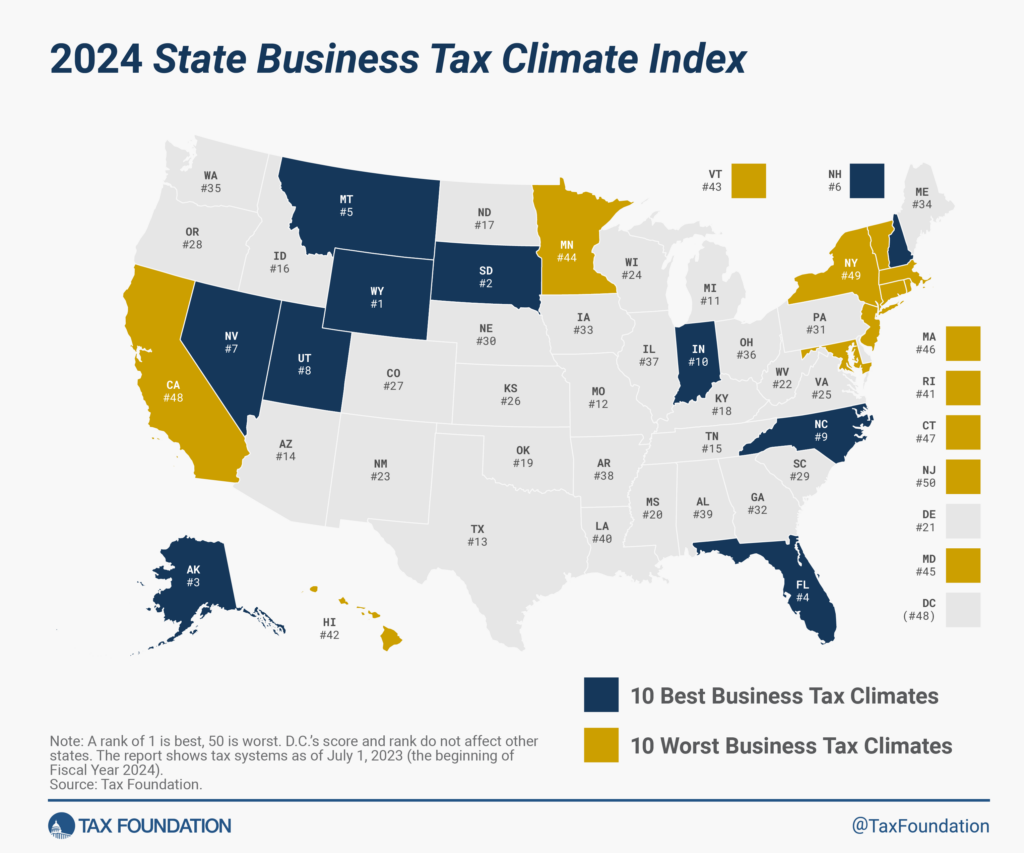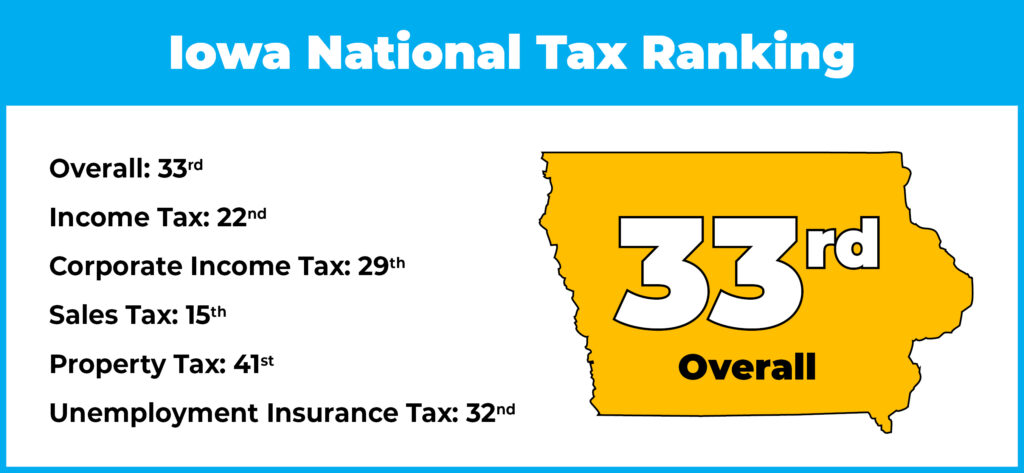The Tax Foundation’s ranking, in combination with continuing surpluses, proves that fiscal conservatism is working in Iowa.
Tax rates matter. They are a major factor determining the economic well-being of a state in both the money they leave in the economy and the impressions decision-makers have when comparing states.
The Tax Foundation recently released its annual 2024 State Business Tax Climate Index, which measures the tax competitiveness across the country. Iowa’s standing on the index has been improving every year, and thanks to continuing tax reforms, the 2024 results continued the trend. Last year, Iowa ranked 38th overall; the state now ranks 33rd. For several years, Iowa languished in the bottom 10 business tax climates and is working its way out of the bottom half.

Source: Tax Foundation
The Tax Foundation explains the importance of these results, noting that “states with the best tax systems will be the most competitive at attracting new businesses and most effective at generating economic employment and growth.” They are in economic competition with each other for both jobs and people, and the mass exodus of businesses and residents from high-tax states such as New York, California, and Minnesota show the effect.
The Tax Foundation’s ranking only reflects recent tax reform changes that have been implemented. Income tax rates will continue to be lowered until the 3.9 percent flat rate is achieved in 2026. Starting in January 2024 the corporate income tax will fall from 8.4 percent to 7.1 percent. Eventually the corporate income tax rate will be lowered until it reaches a flat 5.5 percent. This is substantial because not too long-ago Iowa had a 12 percent corporate tax rate.
Once Iowa’s flat tax is completely phased in by 2026 it is estimated that Iowa will be ranked 15th overall. “With the full phase-in of the newly enacted reforms, Iowa would rank 15th overall, an improvement of 31 places. This would tie North Carolina for the largest improvement in the Index’s history,” notes Jared Walczak, Vice President of State Projects at the Tax Foundation.
With a 3.9 percent flat tax Iowa will not only have replaced the progressive income tax but reduced the top tax rate by almost 60 percent.
Putting Iowa’s overall rank on the Tax Foundation’s index in context of its sub-rankings for individual taxes provides a sense of where we’ve done well and where we need a sharper focus:

Obviously, a problem area is property taxes, on which Iowa still ranks in the bottom 10. Although the legislature recently passed a comprehensive property tax reform measure that will begin addressing the high property tax burden, more work is needed in this area.
Nevertheless, Iowa is attracting much-deserved national attention for the pro-growth tax reforms being implemented by Governor Kim Reynolds and the legislature. Since 2018, they have placed a priority not only on lowering income tax rates, but also on making the tax code more competitive. In 2022, Iowa led the state “flat tax revolution” in the United States with the most-extensive tax reform measure in the nation.
Iowa’s status as a gold-standard leader in state tax reform would not be possible without the commitment of Governor Reynolds and the legislature to conservative budgeting. The foundation of a successful tax reform policy must be spending restraint.
Following prudent budgeting, Iowa has seen multiple rounds of budget surpluses, including $1.8 billion for fiscal year 2023. This was $86.3 million higher than originally projected, and future surpluses are projected to be $2.1 billion for fiscal year 2024 and $2.9 billion for fiscal year 2025.
Meanwhile, Iowa’s reserve funds (Cash Reserve and Economic Emergency) are full, at $961.9 million. Additionally, the Taxpayer Relief Fund is increasing in size. The fund currently has a $2.7 billion balance, which is expected to grow to $3.6 billion in fiscal year 2024 and to $3.8 billion by fiscal year 2025. Growth in these funds indicates Iowa is still collecting too much from taxpayers and has room for further reform.
Governor Reynolds’s stated goal is to not merely the lowest flat tax in the nation, but placing the income tax on a path toward elimination. During the last legislative session, Senator Dan Dawson, chair of the Ways & Means Committee, introduced a tax reform measure that would accelerate rate reductions, lowering the rate until it reached a flat 2.5 percent. Then, the Taxpayer Relief Fund would gradually eliminate the income tax altogether.
Next year Iowa is on track to continue its historic tax reform efforts. Accelerating existing tax rate reductions and working toward a lower flat income tax rate of 2.4 percent or lower are all achievable. This also includes the possibility of placing the income tax on a path toward elimination.
The Tax Foundation’s ranking, in combination with continuing surpluses, proves that fiscal conservatism is working in Iowa. Viewed from any direction, spending restraint and lower taxes are joining a stronger economy with greater economic liberty.
